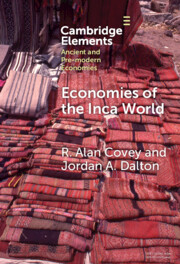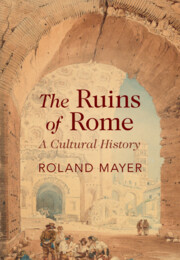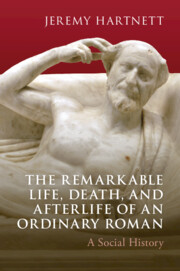Refine search
Actions for selected content:
23916 results in Ancient history
Acknowledgments
-
- Book:
- The Remarkable Life, Death, and Afterlife of an Ordinary Roman
- Published online:
- 16 December 2024
- Print publication:
- 23 January 2025, pp ix-x
-
- Chapter
- Export citation
Part II - The Many Afterlives of Flavius Agricola
-
- Book:
- The Remarkable Life, Death, and Afterlife of an Ordinary Roman
- Published online:
- 16 December 2024
- Print publication:
- 23 January 2025, pp 107-154
-
- Chapter
- Export citation
Epilogue
- from Part II - The Many Afterlives of Flavius Agricola
-
- Book:
- The Remarkable Life, Death, and Afterlife of an Ordinary Roman
- Published online:
- 16 December 2024
- Print publication:
- 23 January 2025, pp 149-154
-
- Chapter
- Export citation
Chapter 4 - Flavia Primitiva, Experience, and Community in the Iseum Campense
- from Part I - The Life and Death of Flavius Agricola
-
- Book:
- The Remarkable Life, Death, and Afterlife of an Ordinary Roman
- Published online:
- 16 December 2024
- Print publication:
- 23 January 2025, pp 61-77
-
- Chapter
- Export citation
Chapter 8 - Flavius in the Modern World
- from Part II - The Many Afterlives of Flavius Agricola
-
- Book:
- The Remarkable Life, Death, and Afterlife of an Ordinary Roman
- Published online:
- 16 December 2024
- Print publication:
- 23 January 2025, pp 129-148
-
- Chapter
- Export citation
Chapter 7 - Flavius Agricola in Early Modern Rome
- from Part II - The Many Afterlives of Flavius Agricola
-
- Book:
- The Remarkable Life, Death, and Afterlife of an Ordinary Roman
- Published online:
- 16 December 2024
- Print publication:
- 23 January 2025, pp 112-128
-
- Chapter
- Export citation
Index
-
- Book:
- The Remarkable Life, Death, and Afterlife of an Ordinary Roman
- Published online:
- 16 December 2024
- Print publication:
- 23 January 2025, pp 188-194
-
- Chapter
- Export citation
Chapter 5 - To Eat Is to Be? Flavius’ Worldview in Perspective
- from Part I - The Life and Death of Flavius Agricola
-
- Book:
- The Remarkable Life, Death, and Afterlife of an Ordinary Roman
- Published online:
- 16 December 2024
- Print publication:
- 23 January 2025, pp 78-91
-
- Chapter
- Export citation
Part I - The Life and Death of Flavius Agricola
-
- Book:
- The Remarkable Life, Death, and Afterlife of an Ordinary Roman
- Published online:
- 16 December 2024
- Print publication:
- 23 January 2025, pp 7-106
-
- Chapter
- Export citation
Chapter 2 - The Person, A Life, and Its Presentation
- from Part I - The Life and Death of Flavius Agricola
-
- Book:
- The Remarkable Life, Death, and Afterlife of an Ordinary Roman
- Published online:
- 16 December 2024
- Print publication:
- 23 January 2025, pp 25-43
-
- Chapter
- Export citation
Contents
-
- Book:
- The Remarkable Life, Death, and Afterlife of an Ordinary Roman
- Published online:
- 16 December 2024
- Print publication:
- 23 January 2025, pp v-vi
-
- Chapter
- Export citation
References
-
- Book:
- The Remarkable Life, Death, and Afterlife of an Ordinary Roman
- Published online:
- 16 December 2024
- Print publication:
- 23 January 2025, pp 176-187
-
- Chapter
- Export citation
Chapter 6 - Meeting Flavius at the Tomb
- from Part I - The Life and Death of Flavius Agricola
-
- Book:
- The Remarkable Life, Death, and Afterlife of an Ordinary Roman
- Published online:
- 16 December 2024
- Print publication:
- 23 January 2025, pp 92-106
-
- Chapter
- Export citation
Chapter 3 - Flavia Primitiva: Wife, Mother, Casta Cultrix
- from Part I - The Life and Death of Flavius Agricola
-
- Book:
- The Remarkable Life, Death, and Afterlife of an Ordinary Roman
- Published online:
- 16 December 2024
- Print publication:
- 23 January 2025, pp 44-60
-
- Chapter
- Export citation
Copyright page
-
- Book:
- The Remarkable Life, Death, and Afterlife of an Ordinary Roman
- Published online:
- 16 December 2024
- Print publication:
- 23 January 2025, pp iv-iv
-
- Chapter
- Export citation

Economies of the Inca World
-
- Published online:
- 09 January 2025
- Print publication:
- 30 January 2025
-
- Element
- Export citation

The Ruins of Rome
- A Cultural History
-
- Published online:
- 02 January 2025
- Print publication:
- 06 February 2025

The Remarkable Life, Death, and Afterlife of an Ordinary Roman
- A Social History
-
- Published online:
- 16 December 2024
- Print publication:
- 23 January 2025
Chapter 10 - Imperial Gardens in Early Roman and Chinese Empires
- from Part III - Urban Places
-
-
- Book:
- Place and Performance in Ancient Greece, Rome, and China
- Published online:
- 28 November 2024
- Print publication:
- 05 December 2024, pp 318-346
-
- Chapter
- Export citation
Part I - Crafting Space and Place
-
- Book:
- Place and Performance in Ancient Greece, Rome, and China
- Published online:
- 28 November 2024
- Print publication:
- 05 December 2024, pp 17-86
-
- Chapter
- Export citation
